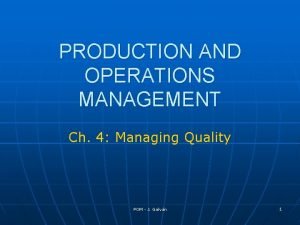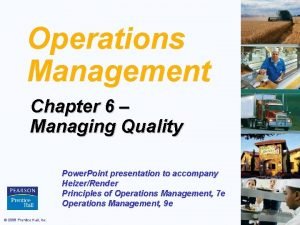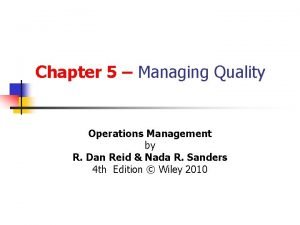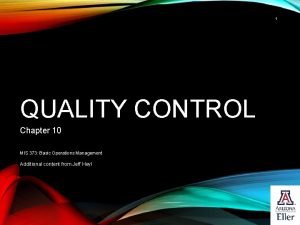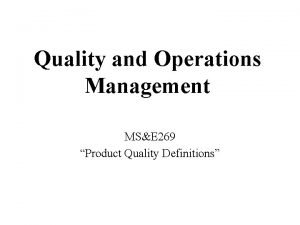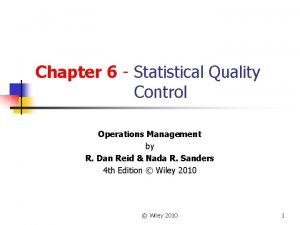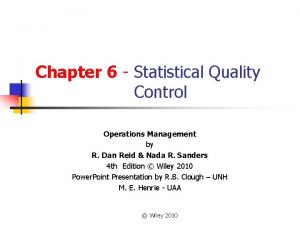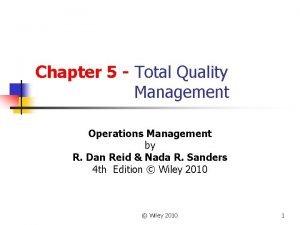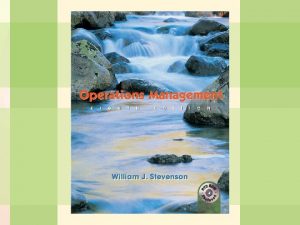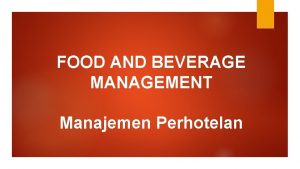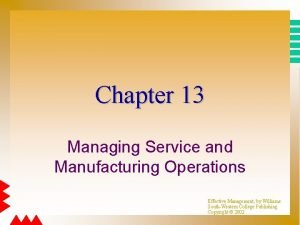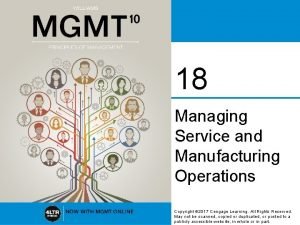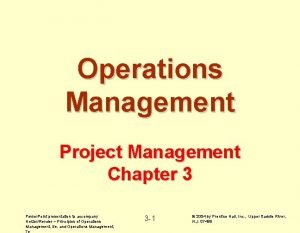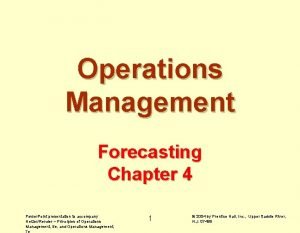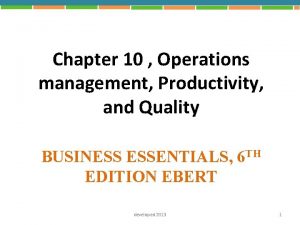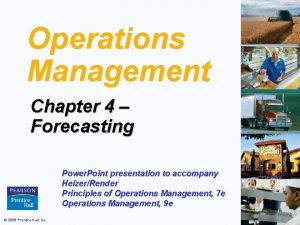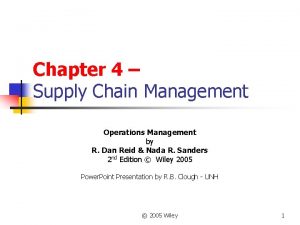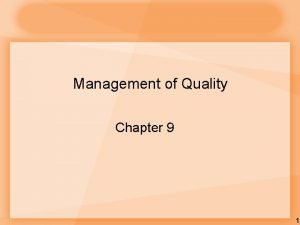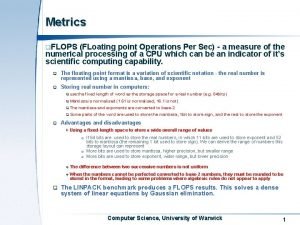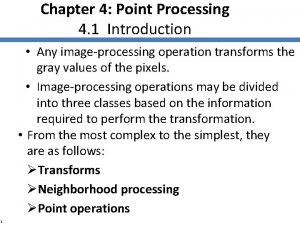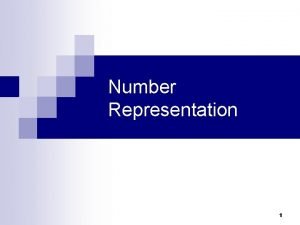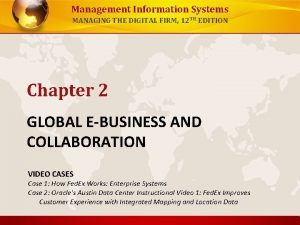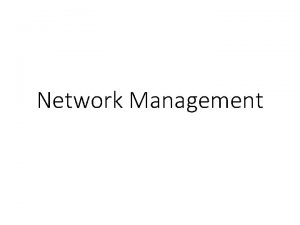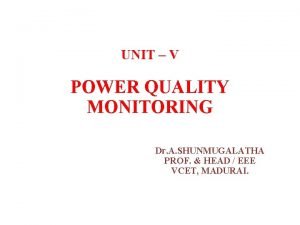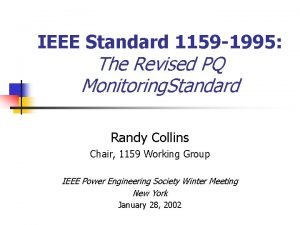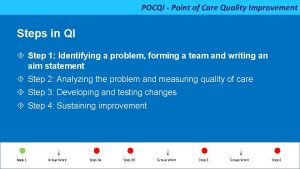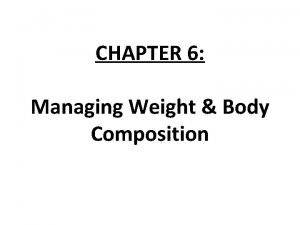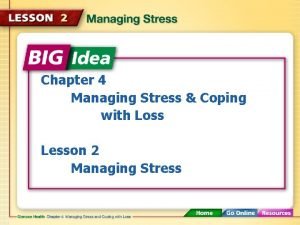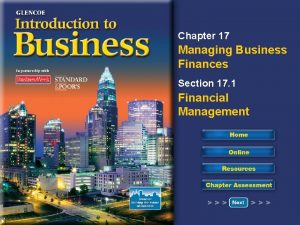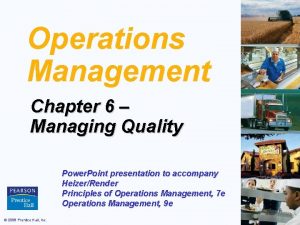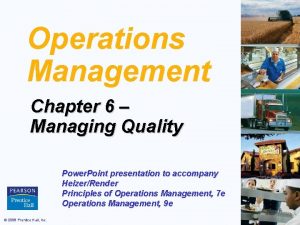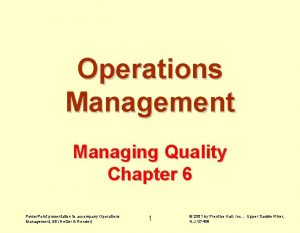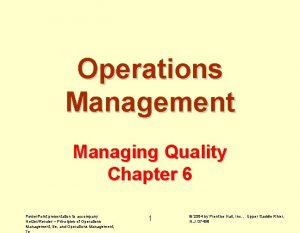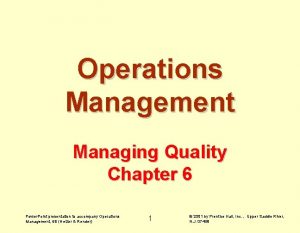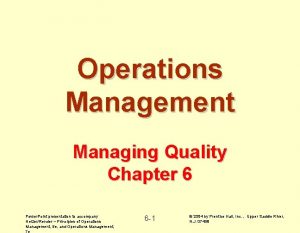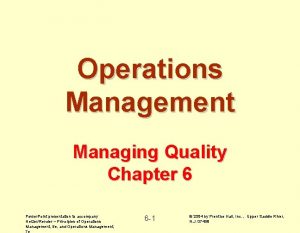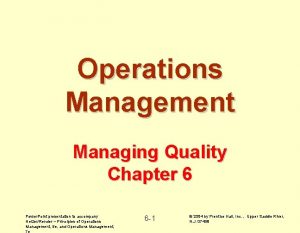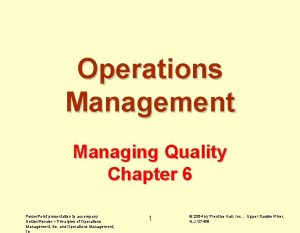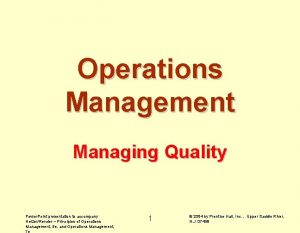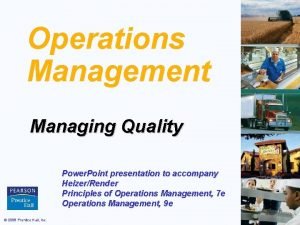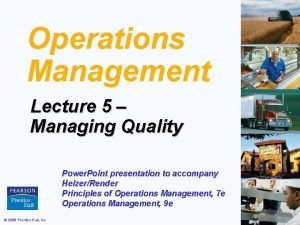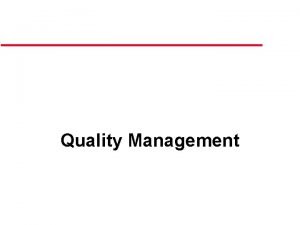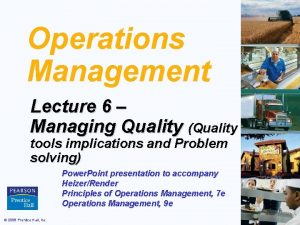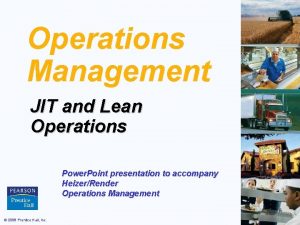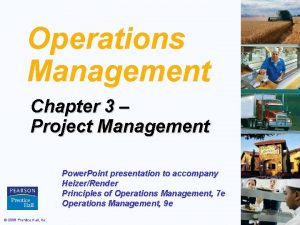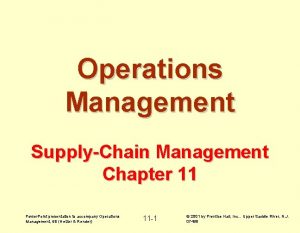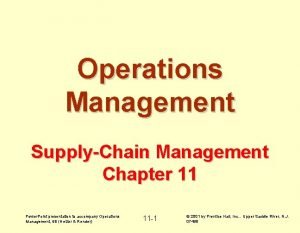Operations Management Chapter 6 Managing Quality Power Point








































































- Slides: 72

Operations Management Chapter 6 – Managing Quality Power. Point presentation to accompany Heizer/Render Principles of Operations Management, 6 e Operations Management, 8 e © 2006 Prentice Hall, Inc. © 2006 Prentice 6–

Outline þ Global Company Profile: Arnold Palmer Hospital þ Quality And Strategy þ Defining Quality þ Implications of Quality þ Malcolm Baldrige National Quality Award þ Cost of Quality (COQ) © 2006 Prentice Hall, Inc. 6–

Outline – Continued þ Ethics and Quality Management þ International Quality Standards þ ISO 9000 þ ISO 14000 © 2006 Prentice Hall, Inc. 6–

Outline – Continued þ Total Quality Management þ Continuous Improvement þ Six Sigma þ Employee Empowerment þ Benchmarking þ Just-in-Time (JIT) þ Taguchi Concepts þ Knowledge of TQM Tools © 2006 Prentice Hall, Inc. 6–

Outline – Continued þ Tools Of TQM þ Check Sheets þ Scatter Diagrams þ Cause-and-Effect Diagram þ Pareto Charts þ Flow Charts þ Histograms þ Statistical Process Control (SPC) © 2006 Prentice Hall, Inc. 6–

Outline – Continued þ The Role Of Inspection þ When and Where to Inspect þ Source Inspection þ Service Industry Inspection þ Inspection of Attributes versus Variables þ TQM In Services © 2006 Prentice Hall, Inc. 6–

Learning Objectives When you complete this chapter, you should be able to: Identify or Define: þ Quality þ Malcolm Baldrige National Quality Award þ ISO International Quality Standards þ Taguchi Concepts © 2006 Prentice Hall, Inc. 6–

Learning Objectives When you complete this chapter, you should be able to: Explain: þ Why quality is important þ Total Quality Management (TQM) þ Seven tools of TQM þ Quality robust products þ Deming, Juran, Feigenbaum, and Crosby’s ideas © 2006 Prentice Hall, Inc. 6–

Managing Quality Provides a Competitive Advantage Arnold Palmer Hospital þ Deliver over 10, 000 babies annually þ Virtually every type of quality tool is employed þ Continuous improvement þ Employee empowerment þ Benchmarking þ Just-in-time þ Quality tools © 2006 Prentice Hall, Inc. 6–

Quality and Strategy þ Managing quality supports differentiation, low cost, and response strategies þ Quality helps firms increase sales and reduce costs þ Building a quality organization is a demanding task © 2006 Prentice Hall, Inc. 6 – 10

Ways Quality Improves Productivity Sales Gains þ Improved response þ Higher Prices Improved Quality þ Improved reputation Reduced Costs þ Increased productivity Increased Profits þ Lower rework and scrap costs þ Lower warranty costs Figure 6. 1 © 2006 Prentice Hall, Inc. 6–

The Flow of Activities Organizational Practices Leadership, Mission statement, Effective operating procedures, Staff support, Training Yields: What is important and what is to be accomplished Quality Principles Customer focus, Continuous improvement, Benchmarking, Just-in-time, Tools of TQM Yields: How to do what is important and to be accomplished Employee Fulfillment Empowerment, Organizational commitment Yields: Employee attitudes that can accomplish what is important Figure 6. 2 © 2006 Prentice Hall, Inc. Customer Satisfaction Winning orders, Repeat customers Yields: An effective organization with a competitive advantage 6–

Defining Quality The totality of features and characteristics of a product or service that bears on its ability to satisfy stated or implied needs American Society for Quality © 2006 Prentice Hall, Inc. 6 – 13

Different Views þ User-based – better performance, more features þ Manufacturing-based – conformance to standards, making it right the first time þ Product-based – specific and measurable attributes of the product © 2006 Prentice Hall, Inc. 6 – 14

Implications of Quality 1. Company reputation þ þ Perception of new products Employment practices þ Supplier relations 2. Product liability þ Reduce risk 3. Global implications þ Improved ability to compete © 2006 Prentice Hall, Inc. 6 – 15

Key Dimensions of Quality þ Performance þ Features þ Durability þ Serviceability þ Reliability þ Conformance þ Aesthetics þ Perceived quality þ Value © 2006 Prentice Hall, Inc. 6 – 16

Malcom Baldrige National Quality Award þ Established in 1988 by the U. S. government þ Designed to promote TQM practices þ Recent winners þ The Bama Companies, Kenneth W. Monfort College of Business, Caterpillar Financial Services, Baptist Hospital, Clarke American Checks, Los Alamos National Bank © 2006 Prentice Hall, Inc. 6–

Baldrige Criteria Applicants are evaluated on: Categories Leadership Strategic Planning Customer & Market Focus Information & Analysis Human Resource Focus Process Management Organizational Results © 2006 Prentice Hall, Inc. Points 120 85 85 90 85 85 450 6 – 18

Takumi A Japanese character that symbolizes a broader dimension than quality, a deeper process than education, and a more perfect method than persistence © 2006 Prentice Hall, Inc. 6–

Costs of Quality þ Prevention costs - reducing the potential for defects þ Appraisal costs - evaluating products, parts, and services þ Internal failure - producing defective parts or service before delivery þ External costs - defects discovered after delivery © 2006 Prentice Hall, Inc. 6–

Costs of Quality Total Cost External Failure Internal Failure Prevention Appraisal Quality Improvement © 2006 Prentice Hall, Inc. 6 – 21

International Quality Standards þ Industrial Standard Z 8101 -1981 (Japan) þ Specification for TQM þ ISO 9000 series (Europe/EC) þ Common quality standards for products sold in Europe (even if made in U. S. ) þ 2000 update places greater emphasis on leadership and customer satisfaction þ ISO 14000 series (Europe/EC) © 2006 Prentice Hall, Inc. 6–

ISO 14000 Environmental Standard Core Elements: þ þ Environmental management þ þ Performance evaluation Auditing Labeling þ Life-cycle assessment © 2006 Prentice Hall, Inc. 6–

Leaders in Quality W. Edwards Deming 14 Points for Management Joseph M. Juran Top management commitment, fitness for use Armand Feigenbaum Total Quality Control Philip B. Crosby Quality is Free © 2006 Prentice Hall, Inc. 6 – 24

Ethics and Quality Management þ Operations managers must deliver healthy, safe, quality products and services þ Poor quality risks injuries, lawsuits, recalls, and regulation þ Organizations are judged by how they respond to problems © 2006 Prentice Hall, Inc. 6 – 25

TQM Encompasses entire organization, from supplier to customer Stresses a commitment by management to have a continuing, companywide drive toward excellence in all aspects of products and services that are important to the customer © 2006 Prentice Hall, Inc. 6–

Deming’s Fourteen Points 1. Create consistency of purpose 2. Lead to promote change 3. Build quality into the product; stop depending on inspection 4. Build long term relationships based on performance, not price 5. Continuously improve product, quality, and service 6. Start training 7. Emphasize leadership Table 6. 1 © 2006 Prentice Hall, Inc. 6–

Deming’s Fourteen Points 8. Drive out fear 9. Break down barriers between departments 10. Stop haranguing workers 11. Support, help, improve 12. Remove barriers to pride in work 13. Institute a vigorous program of education and self-improvement 14. Put everybody in the company to work on the transformation Table 6. 1 © 2006 Prentice Hall, Inc. 6–

Seven Concepts of TQM þ Continuous improvement þ Six Sigma þ Employee empowerment þ Benchmarking þ Just-in-time (JIT) þ Taguchi concepts þ Knowledge of TQM tools © 2006 Prentice Hall, Inc. 6–

Continuous Improvement þ Represents continual improvement of all processes þ Involves all operations and work centers including suppliers and customers þ People, Equipment, Materials, Procedures © 2006 Prentice Hall, Inc. 6–

Shewhart’s PDCA Model 1. Plan 4. Act 2. Identify the Implement improvement and make the plan a plan 3. Check Is the plan working? 2. Do Test the plan Figure 6. 3 © 2006 Prentice Hall, Inc. 6 – 31

Six Sigma þ Originally developed by Motorola, Six Sigma refers to an extremely high measure of process capability þ A Six Sigma capable process will return no more than 3. 4 defects per million operations (DPMO) þ Highly structured approach to process improvement © 2006 Prentice Hall, Inc. 6 – 32

Six Sigma 1. Define critical outputs and identify gaps for improvement 2. Measure the work and collect process data 3. Analyze the data DMAIC Approach 4. Improve the process 5. Control the new process to make sure new performance is maintained © 2006 Prentice Hall, Inc. 6 – 33

Six Sigma Implementation þ Emphasize DPMO as a standard metric þ Provide extensive training þ Focus on corporate sponsor support (Champions) þ Create qualified process improvement experts (Black Belts, Green Belts, etc. ) þ Set stretch objectives This cannot be accomplished without a major commitment from top level management © 2006 Prentice Hall, Inc. 6 – 34

Employee Empowerment þ Getting employees involved in product and process improvements þ 85% of quality problems are due to process and material þ Techniques þ Build communication networks that include employees þ Develop open, supportive supervisors þ Move responsibility to employees þ Build a high-morale organization þ Create formal team structures © 2006 Prentice Hall, Inc. 6–

Quality Circles þ Group of employees who meet regularly to solve problems þ Trained in planning, problem solving, and statistical methods þ Often led by a facilitator þ Very effective when done properly © 2006 Prentice Hall, Inc. 6–

Benchmarking Selecting best practices to use as a l standard for performance a n er nt rking i e Us hma ig c ’re b n e b you if nough e þ Determine what to benchmark þ Form a benchmark team þ Identify benchmarking partners þ Collect and analyze benchmarking information þ Take action to match or exceed the benchmark © 2006 Prentice Hall, Inc. 6–

Best Practices for Resolving Customer Complaints þ Make it easy for clients to complain þ Respond quickly to complaints þ Resolve complaints on first contact þ Use computers to manage complaints þ Recruit the best for customer service jobs © 2006 Prentice Hall, Inc. 6–

Just-in-Time (JIT) Relationship to quality: þ JIT cuts the cost of quality þ JIT improves quality þ Better quality means less inventory and better, easier-toemploy JIT system © 2006 Prentice Hall, Inc. 6–

Just-in-Time (JIT) þ ‘Pull’ system of production scheduling including supply management þ Production only when signaled þ Allows reduced inventory levels þ Inventory costs money and hides process and material problems þ Encourages improved process and product quality © 2006 Prentice Hall, Inc. 6–

Just-In-Time (JIT) Example Work in process inventory level (hides problems) Unreliable Vendors © 2006 Prentice Hall, Inc. Scrap Capacity Imbalances 6–

Just-In-Time (JIT) Example Reducing inventory reveals problems so they can be solved Unreliable Vendors © 2006 Prentice Hall, Inc. Scrap Capacity Imbalances 6–

Taguchi Concepts þ Experimental design methods to improve product and process design þ Identify key component and process variables affecting product variation þ Taguchi Concepts þ Quality robustness þ Quality loss function þ Target-oriented quality © 2006 Prentice Hall, Inc. 6–

Quality Robustness þ Ability to produce products uniformly in adverse manufacturing and environmental conditions þ Remove the effects of adverse conditions þ Small variations in materials and process do not destroy product quality © 2006 Prentice Hall, Inc. 6 – 44

Quality Loss Function þ Shows that costs increase as the product moves away from what the customer wants þ Costs include customer dissatisfaction, warranty and service, internal scrap and repair, and costs to society þ Traditional conformance specifications are too simplistic © 2006 Prentice Hall, Inc. 6–

Quality Loss Function L = D 2 C High loss Unacceptable Loss (to producing organization, customer, and society) Poor Good Best Low loss Target-oriented quality yields more product in the “best” category Target-oriented quality brings product toward the target value Frequency Lower © 2006 Prentice Hall, Inc. where L = loss to society D = distance from target value C = cost of deviation Target Upper Specification Conformance-oriented quality keeps products within 3 standard deviations Figure 6. 4 6–

Tools of TQM þ Tools for Generating Ideas þCheck sheets þScatter diagrams þCause and effect diagrams þ Tools to Organize the Data þPareto charts þFlow charts þ Tools for Identifying Problems þHistogram þStatistical process control chart © 2006 Prentice Hall, Inc. 6–

Seven Tools for TQM (a) Check Sheet: An organized method of recording data Defect A B C 1 /// // / 2 / / // 3 / Hour 4 5 / / / 6 / 7 /// // // 8 / //// Figure 6. 5 © 2006 Prentice Hall, Inc. 6–

Seven Tools for TQM Productivity (b) Scatter Diagram: A graph of the value of one variable vs. another variable Absenteeism Figure 6. 5 © 2006 Prentice Hall, Inc. 6–

Seven Tools for TQM (c) Cause and Effect Diagram: A tool that identifies process elements (causes) that might effect an outcome Cause Materials Methods Effect Manpower Machinery Figure 6. 5 © 2006 Prentice Hall, Inc. 6–

Seven Tools for TQM Percent Frequency (d) Pareto Charts: A graph to identify and plot problems or defects in descending order of frequency A B C D E Figure 6. 5 © 2006 Prentice Hall, Inc. 6–

Seven Tools for TQM (e) Flow Charts (Process Diagrams): A chart that describes the steps in a process Figure 6. 5 © 2006 Prentice Hall, Inc. 6–

Seven Tools for TQM (f) Histogram: A distribution showing the frequency of occurrence of a variable Frequency Distribution Repair time (minutes) Figure 6. 5 © 2006 Prentice Hall, Inc. 6–

Seven Tools for TQM (g) Statistical Process Control Chart: A chart with time on the horizontal axis to plot values of a statistic Upper control limit Target value Lower control limit Time Figure 6. 5 © 2006 Prentice Hall, Inc. 6–

Inadequate special meals on-board Methods © 2006 Prentice Hall, Inc. Mistagged bags Bumping policies Poor check-in policies Overbooking policies Mechanical delay on plane Broken luggage carousel Dissatisfied Airline Customer Understaffed crew Understaffed ticket counters Manpower Poorly trained attendants supply of magazines Machinery Deicing equipment not available Inadequate & blankets on-board Material Insufficient clean pillows Cause-and-Effect Diagrams Figure 6. 6 6 – 55

Pareto Charts Data for October Frequency (number) 70 – 60 – 54 – 72 50 – 40 – Number of occurrences 30 – 20 – 12 10 – 4 3 2 Minibar 4% Misc. 3% 0 – Room svc 72% Check-in Pool hours 16% 5% Cumulative percent – 100 – 93 – 88 Causes and percent © 2006 Prentice Hall, Inc. 6 – 56

Flow Charts Packing and shipping process Packing station © 2006 Prentice Hall, Inc. Sealing Weighing Labeling Quick freeze storage (60 Mins) Storage (4 to 6 hrs) Shipping dock 6 – 57

Statistical Process Control (SPC) þ Uses statistics and control charts to tell when to take corrective action þ Drives process improvement þ Four key steps þ Measure the process þ When a change is indicated, find the assignable cause þ Eliminate or incorporate the cause þ Restart the revised process © 2006 Prentice Hall, Inc. 6–

An SPC Chart Plots the percent of free throws missed 20% Upper control limit 10% Coach’s target value 0% | | | | | 1 2 3 4 5 6 7 8 9 Lower control limit Game number Figure 6. 7 © 2006 Prentice Hall, Inc. 6 – 59

Inspection þ Involves examining items to see if an item is good or defective þ Detect a defective product þ Does not correct deficiencies in process or product þ It is expensive þ Issues þ When to inspect þ Where in process to inspect © 2006 Prentice Hall, Inc. 6–

When and Where to Inspect 1. At the supplier’s plant while the supplier is producing 2. At your facility upon receipt of goods from the supplier 3. Before costly or irreversible processes 4. During the step-by-step production processes 5. When production or service is complete 6. Before delivery from your facility 7. At the point of customer contact © 2006 Prentice Hall, Inc. 6–

Inspection þ Many problems þ Worker fatigue þ Measurement error þ Process variability þ Cannot inspect quality into a product þ Robust design, empowered employees, and sound processes are better solutions © 2006 Prentice Hall, Inc. 6 – 62

Source Inspection þ Also known as source control þ The next step in the process is your customer þ Ensure perfect product to your customer Poka-yoke is the concept of foolproof devices or techniques designed to pass only acceptable product © 2006 Prentice Hall, Inc. 6 – 63

Service Industry Inspection Organization What is Inspected Jones Law Office Receptionist performance Standard Is phone answered by the second ring Billing Accurate, timely, and correct format Attorney Promptness in returning calls Table 6. 4 © 2006 Prentice Hall, Inc. 6–

Service Industry Inspection Organization Hard Rock Hotel What is Inspected Standard Reception desk Use customer’s name Doorman Greet guest in less than 30 seconds Room All lights working, spotless bathroom Minibar Restocked and charges accurately posted to bill Table 6. 4 © 2006 Prentice Hall, Inc. 6–

Service Industry Inspection Organization Arnold Palmer Hospital What is Inspected Standard Billing Accurate, timely, and correct format Pharmacy Prescription accuracy, inventory accuracy Lab Audit for lab-test accuracy Nurses Charts immediately updated Admissions Data entered correctly and completely Table 6. 4 © 2006 Prentice Hall, Inc. 6–

Service Industry Inspection Organization Hard Rock Cafe What is Inspected Standard Busboy Serves water and bread within 1 minute Busboy Clears all entrée items and crumbs prior to dessert Waiter Knows and suggest specials and desserts Table 6. 4 © 2006 Prentice Hall, Inc. 6–

Service Industry Inspection Organization Nordstrom’s Department Store What is Inspected Standard Display areas Attractive, well-organized, stocked, good lighting Stockrooms Rotation of goods, organized, clean Salesclerks Neat, courteous, very knowledgeable Table 6. 4 © 2006 Prentice Hall, Inc. 6–

TQM In Services þ Service quality is more difficult to measure than the quality of goods þ Service quality perceptions depend on þ Intangible differences between products þ Intangible expectations customers have of those products © 2006 Prentice Hall, Inc. 6–

Service Quality The Operations Manager must recognize: 1. The tangible component of services is important 2. The service process is important 3. The service is judged against the customer’s expectations 4. Exceptions will occur © 2006 Prentice Hall, Inc. 6 – 70

Service Specs at UPS © 2006 Prentice Hall, Inc. 6 – 71

Determinants of Service Quality þ Reliability þ Responsiveness þ Competence þ Access þ Courtesy þ Communication © 2006 Prentice Hall, Inc. þ Credibility þ Security þ Understanding/ knowing the customer þ Tangibles 6–
 Managing quality in operations management
Managing quality in operations management Chapter 6 managing quality
Chapter 6 managing quality Managing quality in operations management
Managing quality in operations management Operations and quality management
Operations and quality management What is tqm
What is tqm Operations management chapter 10 quality control solutions
Operations management chapter 10 quality control solutions Quality and operations management
Quality and operations management Statistical quality control in operations management
Statistical quality control in operations management Statistical quality control in operations management
Statistical quality control in operations management House of quality operations management
House of quality operations management Quality in operations management
Quality in operations management Operations management chapter 12 inventory management
Operations management chapter 12 inventory management The real lesson 21
The real lesson 21 Informsu
Informsu Point point power
Point point power Food and beverage cycle
Food and beverage cycle Managing service and manufacturing operations
Managing service and manufacturing operations Managing service and manufacturing operations
Managing service and manufacturing operations Managing front office operations 10th edition
Managing front office operations 10th edition Flight operational quality assurance
Flight operational quality assurance Operations management chapter 3 ppt
Operations management chapter 3 ppt Operations management chapter 4 forecasting solutions
Operations management chapter 4 forecasting solutions Operations management chapter 2
Operations management chapter 2 Chapter 1 operations management
Chapter 1 operations management Product selection and design in operations management
Product selection and design in operations management Operations management chapter 10
Operations management chapter 10 Chapter 8 operations management
Chapter 8 operations management Forecasting in operations management
Forecasting in operations management Cross over charts
Cross over charts Associative forecasting example
Associative forecasting example Chapter 11 operations management
Chapter 11 operations management Follow demand exactly
Follow demand exactly Operations management chapter 4
Operations management chapter 4 Competitive operations strategy
Competitive operations strategy Contemporary management theory ppt
Contemporary management theory ppt Perform quality assurance
Perform quality assurance Quality control vs quality assurance pmp
Quality control vs quality assurance pmp What are quality standards in project management
What are quality standards in project management Quality assurance cycle in nursing
Quality assurance cycle in nursing Compliance vs quality
Compliance vs quality Basic concepts of quality control
Basic concepts of quality control Quality gurus of tqm
Quality gurus of tqm Quality is free: the art of making quality certain
Quality is free: the art of making quality certain Old quality vs new quality
Old quality vs new quality Chapter 9 management of quality
Chapter 9 management of quality Floating point operations per seconds
Floating point operations per seconds Fractal image
Fractal image Point processing operations
Point processing operations Floating point
Floating point Point processing operations
Point processing operations Managing assets vs asset management
Managing assets vs asset management Asset management vs project management
Asset management vs project management Management information system managing the digital firm
Management information system managing the digital firm Managing entity network management
Managing entity network management Accounting management in network management
Accounting management in network management Management information systems managing the digital firm
Management information systems managing the digital firm Introduction to power quality
Introduction to power quality Permanent power quality monitoring equipment
Permanent power quality monitoring equipment Ieee 1159-1995
Ieee 1159-1995 Pocqi
Pocqi Chapter 1 managing risk when driving
Chapter 1 managing risk when driving Chapter 8 managing stress and anxiety
Chapter 8 managing stress and anxiety Chapter 4 managing stress and coping with loss notes
Chapter 4 managing stress and coping with loss notes Auditory distraction while driving
Auditory distraction while driving Chapter 8 managing distractions answers
Chapter 8 managing distractions answers Chapter 6 managing weight and body composition
Chapter 6 managing weight and body composition When you apply the ipde process
When you apply the ipde process Chapter 5 managing risk with the ipde process test answers
Chapter 5 managing risk with the ipde process test answers Chapter 4 lesson 2 managing stress answer key
Chapter 4 lesson 2 managing stress answer key Managing risk with the ipde process
Managing risk with the ipde process Chapter 4 managing in a global environment
Chapter 4 managing in a global environment Chapter 18 managing anxiety
Chapter 18 managing anxiety Chapter 17 managing business finances worksheet answers
Chapter 17 managing business finances worksheet answers
